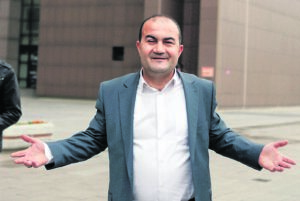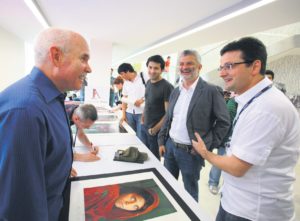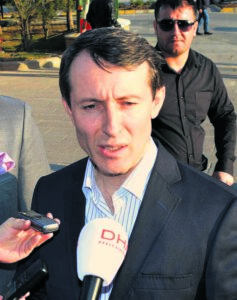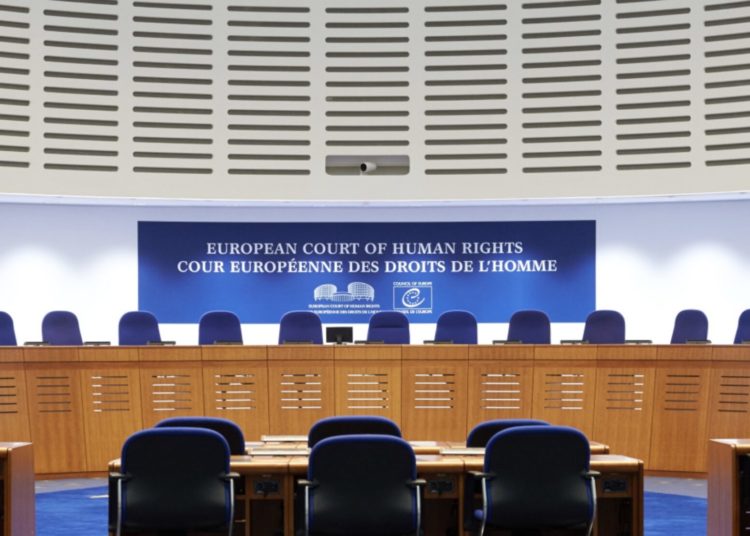Abdullah Bozkurt/Stockholm
The authoritarian government of Turkish President Recep Tayyip Erdogan submitted a forged letter to the European Court of Human Rights (ECtHR) to justify the unjust imprisonment of two judges who issued rulings contrary to the government’s preferences.
The revelations came to light when the ECtHR issued a judgment on September 13, 2022 in the case of Metin Özçelik and Mustafa Başer, two Turkish judges who applied to the ECtHR in June 2015, citing rights violations due to their unlawful arrest in April 2015.
The ruling specifically mentioned a forged letter included in the Turkish government’s defense statement submitted to Strasbourg, intended to justify the arbitrary arrest of the judges.
The two judges became targets of the Erdogan government after ruling in April 2015 in two separate cases for the release of leading Turkish journalist Hidayet Karaca and 63 police officers who had uncovered politicians’ graft schemes. Karaca and the police officers were illegally arrested on separate dates as part of the Erdogan government’s crackdown on critical journalists and police chiefs who had done nothing other than engage in their profession.
Karaca used to run major national TV network Samanyolu, which aired coverage critical of the Erdogan government before Karaca’s unlawful imprisonment on December 14, 2014, a move that was described by the Committee to Protect Journalists (CPJ) as politically motivated.
Karaca’s detention in prison without an indictment or justifiable reason for the extension of his arrest was challenged by his lawyers in motions submitted to the courts. After four months of legal battles, Özçelik, who was then the İstanbul 29th Court of First Instance judge, and Başer, the İstanbul 32nd Court of First Instance judge, ruled for the journalist’s release pending trial.
ECtHR ruling against Turkey:
The judges also ruled to release from pretrial detention 63 police officers who were unlawfully detained for their roles in investigations carried out by public prosecutors until December 2013 that uncovered massive corruption perpetrated by government officials. Overwhelming evidence, including wiretaps, bank records, surveillance footage and intercepted emails, incriminated Erdogan, his family members and his business and political associates.
The corruption scandals exposed Iranian money laundering schemes utilizing Turkish state banks as well as the criminal activities of a Saudi national previously designated as an al-Qaeda financier by both the US and the UN. Some of the evidence collected by the Turkish police was later used to support a federal case in New York against a Turkish banker and an Iranian gold trader for violations of US laws.
Following apparent government intervention in judicial affairs, release rulings issued by judges were not enforced, and neither the police chiefs nor the journalist were freed from pretrial detention despite the lack of any evidence warranting their continued detention. The government also orchestrated the swift removal of the judges and later their arrest, sending a chilling message across the judiciary as a whole.
The European Association of Judges (EAJ) issued a statement of solidarity with jailed judges and called on the Erdogan government to immediately free the two judges. “Any attempt to undermine the freedom of a judge to establish facts and apply the law in a particular case constitutes a clear breach of [the] principle of judicial independence,” the EAJ said. “The EAJ condemns the arrest and detention of any judge on the basis of a decision taken in the exercise of the judge’s judicial functions and calls for the immediate release of the judges.”
In June 2015 the Consultative Council of European Judges (CCJE), an advisory body of the Council of Europe on issues related to the independence, impartiality and competence of judges, also said the suspension and arrest of judges in Turkey over their decision-making might endanger the impartiality and the independence of the judiciary.

None of the domestic or international criticism deterred the Erdogan government from moving forward with its crackdown on members of the judiciary, lawyers, journalists and critics. The rule of law was effectively suspended, with the government calling the shots as judge, jury and executioner.
The government even went after the judges’ family members. Özçelik’s wife, Hatice, a medical doctor, was laid off by the private Bezm-i Alem University Hospital with no reason given, while his son Mehmet Mert was expelled from the kindergarten he was attending. Başer’s wife, Rabia, also a judge, was dismissed from her job and later imprisoned on fabricated charges. She spent four years, seven months and 15 days in jail and was released in 2021. Rabia became a target of the government when she, as the presiding judge in the Istanbul 10th Administrative Court, ruled to cancel Erdogan’s project to turn Gezi Park in Istanbul’s historic district into a shopping center, a plan that had sparked protests in the summer of 2013. The decision was later upheld by the Council of State. The Gezi Park protesters welcomed the decision and described it as a victory.
Both Özçelik and Başer challenged their unlawful arrests in Turkish courts, all the way up to the Constitutional Court, but to no avail. The entire judiciary was restructured by the Erdogan government, which purged over 4,000 judges and prosecutors — approximately 30 percent of the entire judiciary — in an arbitrary and summary move. These vacancies were often filled with partisans and loyalists, many of whom were appointed from the ranks of the ruling party.
It was the ECtHR that finally offered a partial remedy to the injustices suffered by these two judges at the hands of the Erdogan government. The ECtHR ruling in September 2022 declared that Turkey had violated Article 5 § 1 of the European Convention on Human Rights (ECHR) and said the judges’ detention was unlawful because there was no prior authorization by the judicial council for initiating criminal investigations into them.
Under Turkish constitutional articles and laws, judges and prosecutors have procedural immunity in the form of a required prior authorization for the initiation of criminal investigations into them, aimed at preserving their independence. Consequently, the opening of investigations of judges and prosecutors for offenses related to their duties is conditional on authorization to be given by the Ministry of Justice, acting as the president of the Council of Judges and Prosecutors (HSK).
A page from the forensic report that shows the original and forged letters:
The Erdogan government did not even bother to follow procedural rules and blatantly violated the rights of the judges by jailing them pending trial.
The only ECtHR judge who opposed to the Strasbourg court ruling on unlawful detention was Saadet Yüksel, a Turk who secured a seat on the ECtHR after the persistent lobbying efforts of the Erdogan government. Yüksel, whose brother has a senior position in Erdogan’s ruling Justice and Development Party (AKP), is considered to be the Erdogan government’s Trojan horse in the Strasbourg rights court. She is known for consistently standing apart from the majority in human rights cases involving Turkey and siding with the Erdogan government in rights violation cases.
The European court also found a violation regarding the lack of reasonable suspicion that the judges had committed an offense, effectively undermining the Erdogan government’s claims that the judges committed a crime by issuing rulings allegedly under orders from the Gülen movement. This group is critical of the Erdogan government on a range of issues, from pervasive corruption in governance to Turkey’s support of radical jihadist groups.
To substantiate the false claim of judges acting under the movement’s guidance, the Turkish government submitted a forged letter allegedly written and signed by Fethullah Gülen, a US-based Turkish cleric who inspired the movement, to the ECtHR.

The forged letter purportedly showed Gülen instructing judges to issue a favorable ruling for the release of detained journalists and police investigators. It was mysteriously discovered among the belongings of Fevzi Yazıcı, the jailed art director of the now-closed Zaman daily, a critical newspaper that was the most highly circulated paper in Turkey until March 2016, when the government unlawfully seized it.
Yazıcı was one of dozens of journalists imprisoned on July 27, 2016, with no evidence of any criminal activity, as part of an unprecedented crackdown on critical journalists and independent media outlets in Turkey. In a highly unusual move, he was taken from Silivri Prison to Istanbul police headquarters on December 15, 2017 and questioned again, this time about the alleged evidence collected from his home.
It turned out that the government, 16 months after the journalist’s arrest, planted the forged letter on a seized Kingston 16-GB capacity flash drive in order to incriminate Yazıcı and others who were accused of acting on behalf of Gülen in violation of Turkish law.
Yazıcı submitted an expert report proving how the letter was forged and planted on the flash drive. The 15-page report, prepared by Ümit Karabıyık, a professor of computer and information technology and a leading forensic expert, on February 6, 2018 revealed how government officials had erred in trying to fabricate evidence in the journalist’s case. Karabıyık’s conclusion was that the letter was completely forged. The signature of Gülen was taken from a letter he wrote to then-Turkish president Abdullah Gul, which was publicized in January 2014.
15-page forensic report concludes the letter was forged:
According to the report, Error Level Analysis (ELA), a tool used for detecting inconsistencies and potential manipulation in digital images, revealed that the letter was forged. ELA analyzes digital images to determine the compression ratio between the original image and the manipulated image, as these compression ratios typically differ. In this case, the compression ratio for the content indicated that the fabricated message in the letter had been pasted onto the original letter.
The Level Sweep, another forensic tool used to identify forgery, also indicated that both the authentic letter and the forged letter had the same background and pattern. This finding further supported the conclusion that the letter was copied, with different content added onto it later.
The expert also discovered that Gülen’s signature on the original letter was exactly the same as the one in the forged letter, suggesting that they were copied. Forensic experts have long maintained that while two genuine signatures of the same person can be similar, they can never be identical.
The expert also examined the hash function, which is summary information used by forensic experts to verify the integrity of a dataset. In essence, the flash drive seized from the journalist should have shown that the hash value for both the original drive and its copy were identical. However, the hash value on the copy revealed that the police had copied the image of the drive on January 23, 2017, even though the flash drive was seized on July 27, 2016.
Excerpts from Fevzi Yazıcı’s statement in which he denied having the forged letter in his possession:
In other words, the police waited 16 months to create an image of the flash drive and produce a hash value. The hash value of the original drive was never disclosed, leading the expert to suspect that the content of the flash drive was altered later to incriminate the journalist, Gülen and others accused of crimes by the prosecutors.
In his defense statement on December 15, 2017, Yazıcı also asserted that the search conducted in his home was illegal since his lawyer was not present as required by the Criminal Code on Procedures. Consequently, he refused to sign the police record after the search was completed and the evidence collected by the police was entered into the record. He stated that he had never seen the forged letter before and did not have it on the flash drive.
The police also accused the journalist of obtaining the letter from Gülen himself during a visit to the US in 2015. Yazıcı explained that his trip to the US was for professional purposes. “I go to America every year for the annual conference of the Society for News Design [SND],” he informed the police, adding that he was in the US in 2015 to serve as a judge in “The Best of Newspaper Design™ Creative Competition.” He stated that he had stayed at a hotel arranged by the SND near the US Capitol and attended the conference held by SND at the Newseum in Washington, D.C.
Yazıcı and his team of designers at the Zaman daily led their field for a decade, winning dozens of awards in SND competitions with their designs. Recognized for his work, Yazıcı was also selected to serve on a jury for the SND, the world’s most prestigious institution in the field of newspaper design that includes the world’s leading newspaper and magazine editors, art directors and professors from respected universities around the world.

Turkish authorities also investigated Yazıcı’s guests, US journalists and art directors who came to Turkey to deliver speeches and give lectures at a seminar organized sponsored by the Zaman daily under the umbrella of the +1 Design Days. The group photos taken during these seminars and plane tickets issued for experts in newspaper design, including art directors from The Boston Globe and The New York Times, were collected as criminal evidence from Yazıcı’s home.
When presented with the forged letter, the ECtHR did not bother to examine it because it stated that the evidence emerged two years after the arrest of the Turkish judges and therefore had no bearing on the case.
“Insofar as the Government rely on evidence seized during a search of a certain F.Y.’s home on 26 July 2016, suggesting that the applicants acted upon the instructions of Fetullah Gülen, it should be noted that the relevant evidence was not adduced until long after the applicants’ initial detention. Thus, the Court considers that it is not necessary to examine this evidence to ascertain whether the suspicion existing on the date of their initial detention was “reasonable.” It should be noted in this connection that in the context of the present case, the Court was called upon to examine whether the applicants’ initial detention was based on a reasonable suspicion, and not whether such suspicion persisted in relation to their continued detention.”
The case highlights the extent to which the Erdogan government is willing to deceive judges at the European rights court with fabricated evidence in order to justify its crackdown on critics, opponents and dissidents. ECtHR judges Jon Fridrik Kjølbro, Carlo Ranzoni, Marko Bošnjak, Egidijus Kūris, Branko Lubarda and Pauliine Koskelo, who signed on to the ruling, did not buy into the government’s arguments, all the judges except for the Turkish judge Yüksel, who was planted in Strasbourg to defend the Erdogan government’s dismal track record on human rights violations.
In the meantime, judges Özçelik and Başer were sentenced to 10 years in prison on bogus charges of terrorism and abuse of power after a sham trial that ended in April 2017. Similar to their arbitrary arrest, this conviction is expected to soon be challenged at the ECtHR. Perhaps the Erdogan government will once again attempt to use fabricated evidence, such as the forged letter, to support the unlawful conviction of these judges. Although both completed the required portion of their sentences on September 27, 2021 and ought to be released on conditional parole, the government is still keeping them in prison for no reason whatsoever. Başer was also hospitalized several times and underwent three surgeries due to the cancer that developed while he was in prison. He needs to be released for proper care, yet the Erdogan government refuses to do so.












